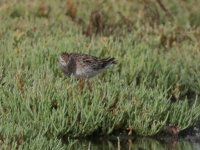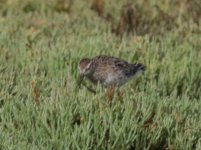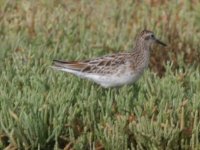Gary Allport
Member
Dear All
I refound this bird this morning first located two weeks ago at Macaneta in southern Mozambique when it was first identified as a Pec based on brief views and a few reasonable photos. In the last two weeks it has moulted into Ad summer plum and now shows features of Sharp-T.
I would be grateful for comments on the id. I think the chevron marks on the left flanks clinch it as a Sharp T, and the supporting features of ginger cap, pale supercilium, white eye ring, dark ear coverts, shortish bill with limited yellow base all point in the direction of Sharp T. Does anyone know if the shaft streaking on the vent/und tcovs is clinch for Sharp T - or does pec show that in sum plum? Any other comments on the id would be welcomed. More pics on the Birds Mozambique FB page.
This looks like it will be the first record for Moz and Southern Africa (so is likely to be popular...). Does anyone know of any records in mainland Africa? I know of one in Madagascar.
Thanks
Gary
I refound this bird this morning first located two weeks ago at Macaneta in southern Mozambique when it was first identified as a Pec based on brief views and a few reasonable photos. In the last two weeks it has moulted into Ad summer plum and now shows features of Sharp-T.
I would be grateful for comments on the id. I think the chevron marks on the left flanks clinch it as a Sharp T, and the supporting features of ginger cap, pale supercilium, white eye ring, dark ear coverts, shortish bill with limited yellow base all point in the direction of Sharp T. Does anyone know if the shaft streaking on the vent/und tcovs is clinch for Sharp T - or does pec show that in sum plum? Any other comments on the id would be welcomed. More pics on the Birds Mozambique FB page.
This looks like it will be the first record for Moz and Southern Africa (so is likely to be popular...). Does anyone know of any records in mainland Africa? I know of one in Madagascar.
Thanks
Gary










